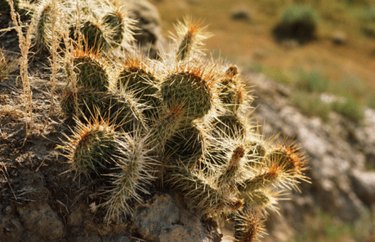
The habitat of a cactus (family Cactaceae) varies wildly, depending on the species. You might think of the desert and sharp spines when you consider cacti, but some members of the cactus family thrive in the tropics. In general, cacti are native to the Americas and hardy in U.S. Department of Agriculture plant hardiness zones 4 through 12. With approximately 2,000 species in the cactus family, there's a cactus suited for every garden.
Cacti Versus Succulents
Video of the Day
The cactus family is one botanical family amid the more than 25 plant families that include a multitude of succulent species. Both cacti and succulents have fleshy leaves, stems or roots that store water. While many are products of dry climates, not all are desert plants.
Video of the Day
All members of the cactus family are succulents, but are distinguished from other succulent species by the round, modified buds called "areoles" on their stems and/or fleshy pads. These appear as indentations that often sprout spines, and in the case of the Opuntia and Cylindropuntia species, tiny barbed, hairlike spines called glochids. Tropical cacti also feature areoles, but lack the prickly spines, instead sprouting tiny hairs around the edges or between the stem segments.
Desert Habitat of Cactus
Technically, the "desert" cacti don't all live in deserts. Generally, these cacti share a need for a bright and sunny, dry habitat. The soil can be sandy, rocky or organically-rich, as long as it drains well. The prickly pear cacti (Opuntia spp.) thrive in USDA zones 4 through 10, depending on the species. The sprawling eastern prickly pear (Opuntia humifusa) is found in dry open areas ranging from Ontario, Canada south to Florida, while the brittle prickly pear (Opuntia fragilis) grows from northern Alberta to California.
The tallest desert cactus in North America is the saguaro (Carnegiea gigantea), with the record height of 78 feet tall. Native to the Sonoran Desert, these giants thrive in USDA zones 9 through 11 in southern Arizona and California as well as northern Mexico, in elevations from sea level to 4000 feet. The smallest of the desert cacti is Blossfeldia liliputana, at barely 1/2 inch tall and equally wide. Native to the arid habitat between southern Bolivia and northern Argentina, this tiny cactus thrives in rocky cracks and crevices in USDA zones 8 through 10.
Tropical Habitat of Cactus
The best indoor cactus is one of the easy-to-grow holiday cacti. While the cactus names seem to be interchangeable among venders, the holiday cacti are three distinctly different South American epiphyte species, hardy in USDA zones 10 through 12. The Christmas cactus (Schlumbergera bridgesii) has smooth-edged segmented stems, while the Thanksgiving cactus (Schlumbergera truncata) has toothed edges on its segments. The Easter cactus (Rhipsalidopsis gaertneri) has segments with smooth rippled edges and bristles between the segments.
These tropical cacti are rainforest natives, growing in the crevices between the branches and trunks of trees. Their aerial roots absorb moisture from rain and nutrients from the organic debris that accumulates around the plants. The only known cactus that naturally grows outside of the Americas is the mistletoe cactus (Rhipsalis baccifera) which is found in Central and South America, Florida, the Caribbean and tropical Africa in USDA zones 9 through 11. Mistletoe cactus may also be found growing on rocky outcroppings in its native habitat.
To grow at home, provide bright filtered light in a draft-free location. Water when the soil is dry to a depth of 1 inch. Avoid overwatering, but don't allow the plant to completely dry out, either. Tropical cacti prefer an organically-rich, well drained soil, such as equal parts peat moss, compost and coarse sand or perlite.